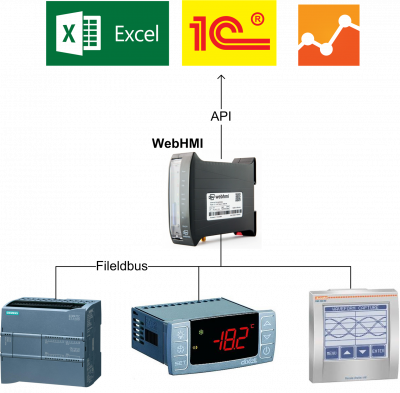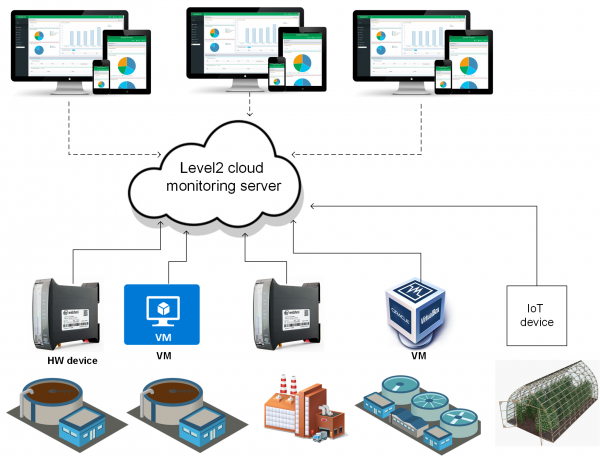Table of Contents
Purpose
The WebHMI's mission in brief is the
“Rapid deployment of WEB-monitoring projects of various facilities, without special knowledge in the field of network technologies and extensive programming skills.”
WEBHMI is a solution that allows the user to effectively solve the task of monitoring the status of various engineering systems and facilities, as well as their remote management.
On the one hand, WEBHMI has built-in support for popular protocols (such as Modbus and other) adopted by manufacturers of industrial equipment, on the other - a direct interface with the user through the built-in web server or through the API to other applications.
With WEBHMI it is possible to solve both simple tasks of the 'control panel' of equipment, in other words - the Human Machine Interface (HMI), and create monitoring systems (dispatching) of distributed objects. Devices (virutal images) can communicate with each other as well as with the central dispatch server, transmitting data reflecting the state of the systems monitored to the upper level.
The process of creating a WEBHMI project is very simple and intuitive, it is basically the same as that adopted in most modern SCADA systems and software of the operator panels. However, its unique feature is that the development tools are integrated directly into the user interface. Thus, the developer does not need specific software, he can work in any OS that is convenient for him, the project does not require compilation and downloading - all actions during the configuration process are immediately reflected in the system, and thanks to the web interface you can work with the project remotely.
Application
Local HMI
The simplest application is a local operator interface for monitoring industrial automation systems and equipment. The ability to manage various devices from any computer, tablet or smartphone, through a web browser, from anywhere on the network or via WiFi. In this case, WEBHMI can integrate into an existing network or act as a stand-alone access point.
Remote HMI
The option is similar to the first, providing access to the interface via the Internet, for monitoring remote objects. In the absence of communication channels, the most rational solution would be to connect WEBHMI to the mobile 3G Internet by simply installing the modem into the USB connector of the device. To access the site, you will need to obtain a static IP address from the provider or connect to an external network using a VPN.
API
The next option involves the possibility of transferring data from the process directly to the target business application via the API
Cloud - based and large distributed solutions
Finally, the variant of constructing a dispatching system for distributed objects, assuming a two-level topology in which WEBHMI acts as data gateways of the lower level, transferring information to a dedicated server that ensures its further processing and storage. For more information about this feature, contact your device vendor.
Application target size
Size means number of registes (tags or variables) in the process - usually the more tags the more screens, reports, control and other features demanding higher performance. Folloing are not strict rules but rather a “rule of thumb”.
- Up to 2-3K (for single facility) - Hardware WebHMI version
- High demanging in terms of performance with 5-10K and more tags - Virtual box image. This image can be installed on a dedicated industrial single - board computer or box PC or on a customer's virtualization server.
- Large disributed applicatoin - Level2 together with WebHMI (of any kind)
- Small size applications, distributed IoT applications - Level2 cloud running virtual image.
- Educational and trial applications - any of virtual images with the respective license.
Disclaimer (What is the WebHMI not for?)
Though WEBHMI has a fairly good means of ensuring its own reliability, avoid using it control functions in mission - critical control or human life saving applications!
The examples of these are:
- military applications
- hazardous production process control
- process control with high failure costly consequences
- fast real-time control, machine automation etc.
However, still it maybe used in these fieldds for monintoring ONLY purposes.



